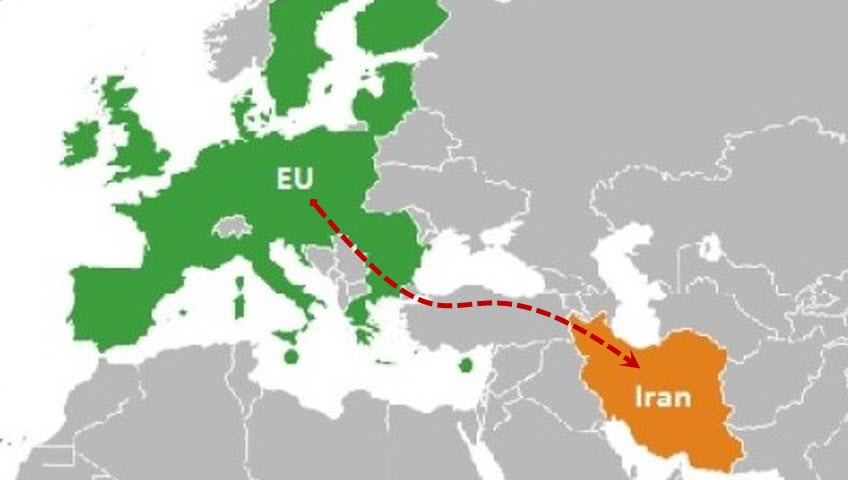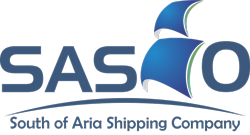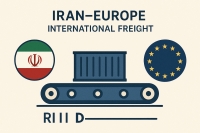Why Iran–Europe International Freight Matters
Iran-Europe international freight represents a critical artery in global trade networks, intertwining economic, strategic, and geopolitical dimensions. At its core, this connection leverages Iran's unique geographical position as a bridge between Asia, the Middle East, and Europe, facilitating the movement of goods that underpin bilateral and multilateral economic activities.
In 2024, total trade in goods between the European Union (EU) and Iran reached €4.5 billion, with EU exports amounting to €3.7 billion and imports at €0.8 billion, supplemented by €1.68 billion in services trade from the previous year. This exchange, while diminished by sanctions, underscores the freight's role in sustaining economic ties amid global uncertainties (policy.trade.ec.europa.eu & webgate.ec.europa.eu)
Despite these hurdles, the freight's importance lies in its potential to diversify global supply chains. Iran's strategic location positions it as a vital transit hub, connecting major markets through corridors like the International North-South Transport Corridor (INSTC), which links Mumbai to Moscow via Tehran and reduces delivery times from 30-40 days by sea to as little as 15 days by rail, saving up to 30% in costs and 40% in time. This multimodal route—encompassing sea, rail, and road—enhances connectivity for landlocked Central Asian countries and provides alternatives to disrupted paths like the Red Sea, amid Houthi attacks, or the Suez Canal (grc.net).
In summary, Iran–Europe international freight is not only a geographic advantage but a measurable logistics opportunity, providing firms with potential efficiency gains, cost optimization, and competitive access to European markets.
Top EU Imports from Iran (2024, HS Sections)
According to the European Commission’s 2024 trade statistics for Iran, the top EU imports from Iran are as follows:
|
Category |
Value (€ million) |
% of Total Imports |
|
Vegetable products |
2,783 |
33.3% |
|
Base metals and articles |
1,301 |
15.6% |
|
Plastics, rubber and articles |
1,261 |
15.1% |
|
Chemical products |
678 |
8.1% |
|
Foodstuffs, beverages, tobacco |
536 |
6.4% |
Top EU Exports to Iran (2024, HS Sections)
According to the European Commission’s 2024 trade statistics for Iran, the top EU exports to Iran are as follows:
|
Category |
Value (€ million) |
% of Total Exports |
|
Machinery and appliances |
1,117 |
30.1% |
|
Chemical products |
1,103 |
29.8% |
|
Optical and photographic instruments |
692 |
18.7% |
|
Foodstuffs, beverages, tobacco |
200 |
5.4% |
|
Vegetable products |
235 |
6.3% |

Key Transport Routes Between Iran and Europe
Iran to Europe freight transport relies on a mix of rail, road, sea, air, and multimodal networks, leveraging Iran's position as a transit hub. The following sections detail the primary modes, drawing on current infrastructure and developments.
Rail Freight from Iran to Europe
Iran Europe rail freight plays a pivotal role in connecting the regions, with the International North-South Transport Corridor (INSTC) as a flagship initiative. This 7,200 km multimodal network, established in 2000 by India, Iran, and Russia, now includes 13 member countries and focuses on rail freight Iran Europe through three main routes: the Western Route via Azerbaijan, the Eastern Route via Turkmenistan and Kazakhstan, and the Trans-Caspian Route involving Caspian Sea ferries.
● The Western Route starts from southern ports like Bandar Abbas, travels north through Iran and Azerbaijan to Russia, and extends to Europe, with the Rasht-Astara rail link (164 km) nearing completion in 2025 under a Russia-Iran agreement, enabling uninterrupted rail flow.
● The Eastern Route, operational since 2014 via the Kazakhstan-Turkmenistan-Iran railway, handles significant volumes, with freight rising 19% to 26.9 million tons in 2024, including 13 million tons by rail.
● The Trans-Caspian hybrid uses ferries from Iranian ports like Anzali or Amirabad to Russian ports like Astrakhan, then rail onward.
The Middle Corridor, or Trans-Caspian International Transport Route (TITR), complements INSTC by linking China through Kazakhstan, the Caspian Sea, Azerbaijan, Georgia, and the Black Sea to Europe, bypassing Russia and integrating with Iran's northern ports. Middle Corridor trade has gained traction as an alternative amid Ukraine-related disruptions, offering resilience for Iran-Europe flows (artarail & eabr.org & mei.edu)

Road Transport Iran to Europe
Road freight Iran Europe utilizes the TIR (Transports Internationaux Routiers) convention, which simplifies customs for sealed cargo across borders, enabling efficient overland movement. Main highways include AH8/E119 (from Makhachkala in Russia through Baku, Azerbaijan, to Anzali and Tehran in Iran) and segments linking Central Asia. Key routes connect Persian Gulf ports like Bandar Abbas to northern borders, integrating with CAREC corridors for enhanced connectivity.
Costs of road transport from Iran to Europe are higher than rail, but TIR reduces duties, making it viable for flexible, door-to-door service (https://eabr.org/)
Sea Shipping Iran to Europe
Shipping goods from Iran to Europe primarily occurs via Bandar Abbas, Iran's main southern port, handling bulk and containerized cargo to Mediterranean ports through the Suez Canal or alternative routes. Connections link to European hubs like Rotterdam or Hamburg, often via transshipment in Dubai or Istanbul.
Chabahar, sanction-exempt, triples capacity to 8.5 million tons, serving as a gateway for south-north flows.
Northern ports like Anzali and Amirabad facilitate hybrid routes to Black Sea and Europe (Eabr)
Air Cargo Iran to Europe
Air cargo between Iran and Europe is limited by sanctions. Major Iranian airports like Tehran Imam Khomeini handle high-value, time-sensitive goods like pharmaceuticals or electronics, with carriers like UPS and FedEx offering compliant services via consolidation. Transit times are 2-5 days, far faster than other modes, but costs are high. Sanctions curb direct flights, forcing rerouting via Turkey or UAE, but it supports niche trade amid broader restrictions.
Multimodal Solutions
Multimodal solutions combine modes for optimal efficiency, with dry ports like Aprin near Tehran serving as logistics hubs for rail-sea-road integration. These facilitate cargo handling without coastal access, reducing damages and emissions by minimizing transshipments. Examples include fruits trucked to Bandar Abbas for sea to Europe, or automobiles railed to ports. Best cargo transfer from Iran to Europe often involves multimodal for cost savings (20-30% vs. single-mode) (Ptbnet)
Practical Steps for Iran to Europe Shippers
Successful Iran–Europe international freight operations require a structured approach to reduce delays, control costs, and ensure full regulatory compliance. The following operational checklist highlights essential steps for shippers:
- Cargo Assessment and Classification – Identify cargo type, HS codes, and special handling requirements. Proper classification affects transport mode, documentation, and cost calculations for international cargo transfer from Iran to Europe.
- Select Optimal Transport Mode – Evaluate rail freight Iran–Europe versus road or multimodal options. Consider transit time, reliability, and cargo transfer from Iran to Europe price to optimize operational efficiency.
- Engage Best Freight Forwarders – Partner with licensed operators familiar with Iran–Europe logistics opportunities to ensure smooth customs clearance and minimized delays.
- Documentation Preparation – Compile invoices, packing lists, certificates of origin, and required permits. Compliance with EU import regulations reduces the risk of shipment rejection or fines.
- Customs and Sanctions Compliance – Verify that all shipments adhere to relevant trade restrictions and sanctions. Proper documentation of duties and inspections is critical.
- Insurance and Risk Management – Secure insurance for multimodal transport covering theft, damage, and transit disruptions.
- Tracking and Monitoring – Implement real-time monitoring systems for rail and road shipments to ensure visibility and timely response to issues.
- Cost Optimization Review – Regularly review cargo transfer from Iran to Europe price, compare transport options, and adjust strategies to maximize efficiency in Iran–Europe international freight.
Operational Feedback Loop – Conduct post-delivery evaluations to refine procedures, identify bottlenecks, and leverage Iran–Europe logistics opportunities for future shipments..
Advantages of Iran–Europe International Freight
- Reduced Transit Times – Rail and multimodal corridors from Iran to Europe significantly shorten delivery compared to maritime-only routes.
- Cost Efficiency – Competitive cargo transfer from Iran to Europe price, particularly for high-volume or consolidated shipments.
- Geographic Advantage – Iran’s central location enables direct connections to Europe via North–South and Middle Corridor routes.
- Modal Flexibility – Shippers can combine rail, road, and short-sea legs to match cargo type, urgency, and budget.
- Improved Freight Frequency – Regular departures on main transit lines increase shipping options for Iranian exporters.
- Access to Logistics Hubs – Strategic dry ports and border terminals facilitate customs processing and cargo consolidation.
Challenges of Iran–Europe International Freight
- Sanctions and Regulatory Restrictions – International sanctions and EU/Iran trade regulations complicate shipments, limiting payment methods and cargo types.
Regulatory Compliance – Adhering to EU import standards, documentation, and sanctions requirements adds administrative burden. - Infrastructure Bottlenecks – Some rail and road segments limit cargo weight or speed, reducing overall efficiency.
- Limited Multimodal Integration – Gaps in seamless rail–road connections can slow shipments and increase handling.
SASCO: Your Strategic Partner for Iran–Europe Freight
With fewer specialized operators managing Iran–Europe international freight, SASCO stands out as a reliable logistics partner. Leveraging extensive regional knowledge, multimodal capabilities, and streamlined customs handling, SASCO enables efficient cargo transfer from Iran to Europe. By optimizing routes, reducing cargo transfer from Iran to Europe price, and ensuring compliance with regulatory and sanctions requirements, SASCO provides businesses with scalable and secure Iran–Europe logistics opportunities.
FAQs
Q:Can Europe trade with Iran?
A: Yes, but trade is limited and regulated due to EU sanctions. Certain goods and financial transactions are restricted.
Q:Can you ship from Iran to the UK?
A:Yes, shipments from Iran to the UK are possible via licensed freight forwarders using rail, road, or multimodal routes, with proper customs documentation.
Q:Does Iran supply oil to Europe?
A:Yes, Iran exports crude oil and petroleum products to Europe, though volumes depend on market demand, logistics capacity, and contractual arrangements.
Q: What is the price of the cargo transfer from Iran to Europe?
A: The cargo transfer from Iran to Europe price varies based on shipment size, transport mode (rail, road, or multimodal), and route selection. Rail freight generally offers competitive rates for bulk shipments, while road or multimodal options may be faster but slightly more expensive.
Q: How long does cargo transfer from Iran to Europe take?
A: Transit times depend on the chosen route and mode. Rail shipments typically take 15–25 days, while road or multimodal transfers may be slightly shorter or longer depending on border crossings and customs processing. Sea routes are generally longer.







